My professional career can be summed up as forty five stressful years of flying in airplanes, traveling to many U.S. and foreign destinations, managing technology prima donnas and marketing executive divas, and pushing products and services of no real consequence. The effort yielded a comfortable home, kids in good schools, nice cars, and two heart attacks. On balance, the “gives” and “gets” worked to our family’s benefit but, by choice, life today is quite different.
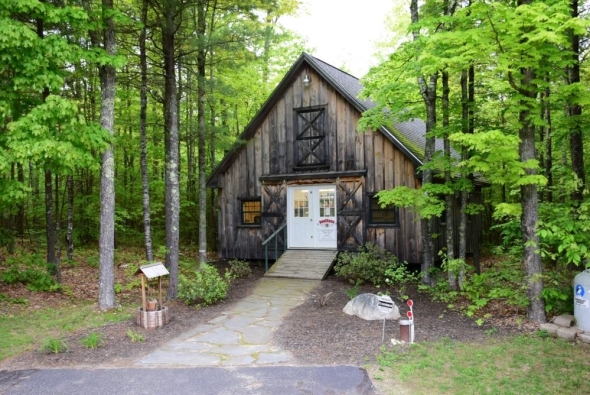
What looks like a barn is actually a quite modern structure. Inside is a small machine shop and test equipment, a place to handload, a place to gunsmith, a place for photography, and a workstation with wireless Internet access that allows me to conduct business without travel. A three hundred yard range behind the shop permits firearm live fire assessment and home is across the driveway if I elect to take a nap or have lunch with my wife. It took a lot of years to earn a tiny bit of freedom.
Why this seemingly off topic narrative, Joe? Good question Shootnscoot57. I’m stalling until I can figure out where and how to begin this piece on the S&W Model 41 and I am trying to avoid being drafted into shopping for a new sofa by my wonderful wife… who is currently looking over my shoulder.
Preamble
For anyone interested in the history of the S&W Model 41, I highly recommend reading or referencing “The History of Smith & Wesson” by Roy G. Jinks and “The Standard Catalog of Smith & Wesson” – Supica and Nahas. Both are well researched and documented. Unfortunately, they are also the sources most often plagiarized inaccurately and misstated on Wikipedia, in firearm forums and by numerous digital publications. The history is well worth a read, but beyond the scope of this article.
It is unfortunate to see YouTube videos with people assessing the Model 41’s performance by rapid fire shooting at, and often missing, twelve inch steel gongs from a distance of seven yards. Why do these folks shoot all handguns as though in the midst of a fire fight or at a combat shooting event? The Model 41 is a Bullseye pistol, generally intended for ranges between 50 feet and 50 yards. Being able to shoot a handgun with precision takes a high degree of skill, a level not generally attained without innate talent and years of intense training and practice. I think it is safe to assume that while most people can master a video camera, few have the ability to shoot a handgun to its potential.
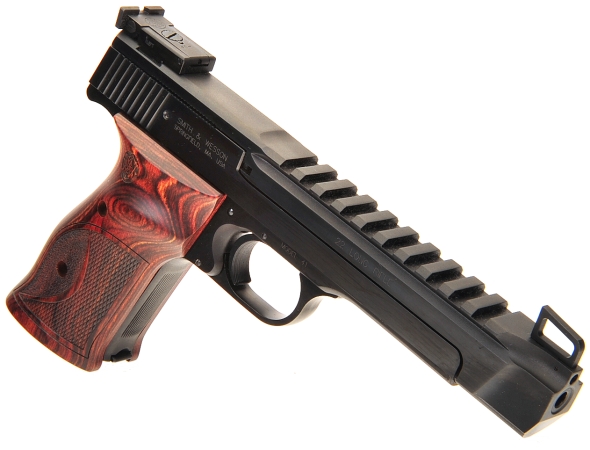
|
Smith & Wesson Performance Center® Model 41 |
|
|
Company |
Smith & Wesson |
| Point of Origin | Springfield, MA |
| SKU # | 178031 |
| Description | 22 LR Rimfire Match Pistol |
| Type of Action | Autoloader SA |
| Caliber | 22 Long Rifle |
| Magazine Capacity | 10 |
| Barrel Length* | 5.50″ |
| Barrel Material | Blued Carbon Steel |
| Barrel Contour | Heavy Profile |
| Rifling | 1:15″ RH Button Rifled |
| Slide | Blued Carbon Steel |
| Frame | Blued carbon Steel |
| Trigger* | 3.0 Lb Pull – Overtravel Stop |
| Grips | Laminated Wood Target |
| Front Sight | Patridge / Interchangeable |
| Rear Sight | Micrometer Click Adjustable |
| Optical Sight Support | Integrated Picatinny Rail |
| Weight of Firearm | 42.2 Oz. |
| Overall Length | 10.5″ |
| Overall Height | 5.4″ |
| Widest Point | 1.6″ Across Thumb Rest |
| Manual Safety | Thumb |
| Magazine Disconnect | No |
| CA/MA/MD State Compliant | Yes |
| MSRP | $1619 |
| * Actual. ** Barrel can be interchanged with 7″ accessory barrel. Includes hard case with two magazines and supporting documents. | |
The S&W Model 41 was a 1957 commercial introduction. It was intended for rimfire Bullseye competition; slow and rapid fire at distances from fifty feet to fifty yards, depending on indoor or outdoor settings and event rules. I know this to be true because I was twelve years old at the time, participating in youth marksmanship programs and wanted, but could not afford a Model 41. Ditto for a fuel injected Corvette, a BSA 650 twin and a Nikon F.
Setting aside the issue of ownership, I did have numerous opportunities to shoot the Model 41 during their early production years and it was everything I anticipated it would be; accurate, well balanced, great trigger, good sights, reliable, nicely finished, and made of substantial and durable materials. Beyond its physical performance, it instilled shooting confidence.
Manufacturers often make great firearms into mediocre firearms by cost reducing the product to stem the rising material, labor and overhead costs. The Model 41 five inch was introduced sixty years ago at $100. Smith & Wesson has obviously elected to taken a different tact, continuing to produce an exceptional product. Inflation might bare responsibility for half the price increase, while maintaining hand assembly, limited production and today’s litigious environment could easily take price increases the rest of the way.
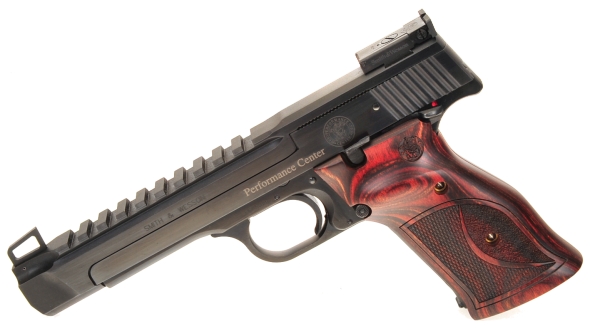
The S&W Model 41 is accurate by design. The barrel assembly with both front and rear sights are cam locked to the frame by the trigger guard and remain stationary during firing. The slide moves under, but does not touch the extended portion of the barrel that mounts the rear sight. It is a very stable assembly with nothing in motion that would effect bore centerline to frame and sight alignment.
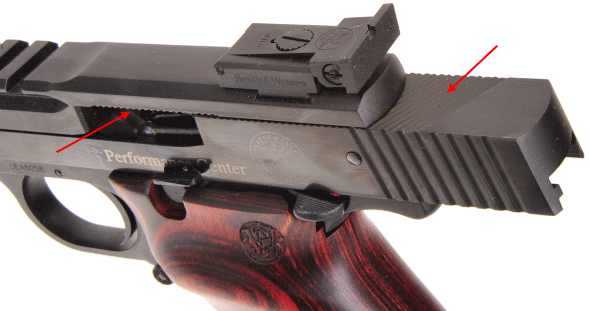
Serrations cut at an angle on the top side of the slide and on the bottom side of the barrel extension clear powder, lead and brass residue before it can accumulate and inhibit reliability.
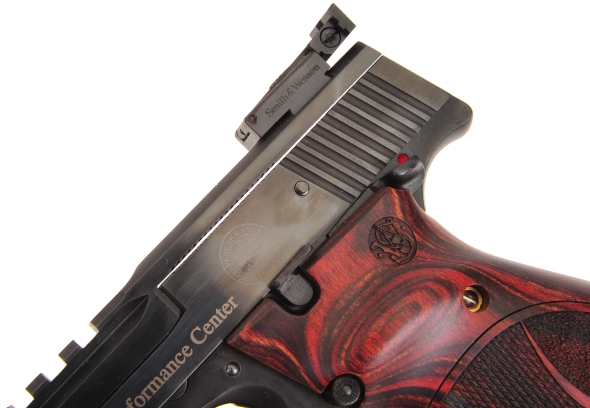
An illustration of the closed slide adjacent slide/barrel serrations and the gap between the two. The gap is essential for free movement of the slide as there are no interlocking rail connecting the two. The slide stop, magazine release and thumb safety controls are not… extravagant in size, but they are positive in actuation and consistent in size for bullseye competition where a shooter would not want to unintentionally make contact with those controls.
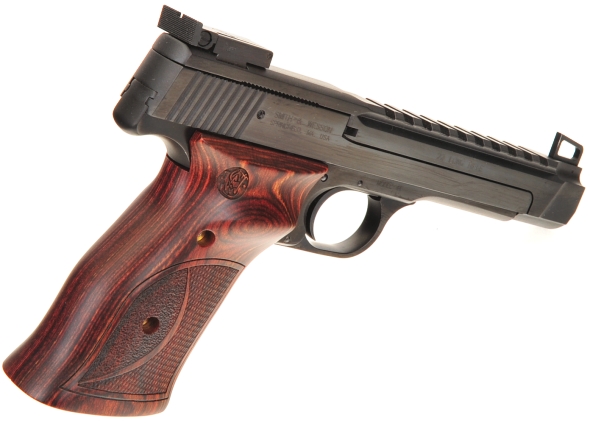
The presence of the Picatinny rail integral to the barrel assembly reflects the inclusion of a red dot optical sight systems in bullseye shooting. The current generation Performance Center® Model 41 mounts both the micro adjustable rear sight and Patridge front sight higher than previous versions, while permitting close to bore mounting of an optical sight. In the event of a red dot sight failure, the front metallic sight would remain visible looking through the tube.

One of the reasons the S&W Model 41 feels so comfortable and familiar in a shooting hand is the grip angle which is the same as a 1911. I have read many debates about grip angles and how swept designs are much more natural to point. Not for me. Perhaps it is experience or muscle memory or extended use of preferential firearms, but the Model 41, just like a 1911, always came down on target without compensation.

The Smith and Wesson Model 41 trigger is excellent. Crisp break at three pounds even, short travel, and an adjustable trigger stop to control overtravel. Out of the box with the rear sight screwed down, the Model 41 shot three inches low at 25 yards, but adjusted easily to get on target. There was only a miniscule shift in point of impact between low velocity target and high velocity ammo. I have seen where people make claims that high velocity ammunition is excluded from use in the Model 41. There is no such restriction by ammunition specified in the pistol’s manual or by Smith & Wesson.

The Model 41 is a comfortable handful with a grip assist from aggressive grip checkering and serrated front strap. The muzzle crown is more deeply recessed than earlier version of the pistol.
Applications and accuracy…
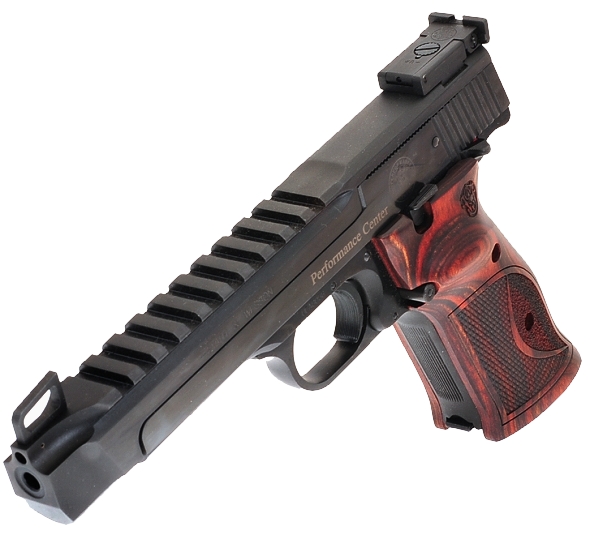
I do not participate in competitive shooting events as that would entail leaving the boonies of Maine and going somewhere else. I do, however, hunt small game and dispatch marauding varmints that are intent on damaging structures and property. In that regard, there is nothing as handy and effective as a highly accurate 22 rimfire.
| Ammunition | Bullet Weight Grains |
Bullet Type |
Mfg 24″ BBL Rated FPS |
Ruger 5.5″ BBL Actual FPS |
25 Yard 5 Shot Group “ |
| Remington Golden Bullet | 40 | RN | 1255 | 1058 | 0.7 |
| Remington Target | 40 | RN | 1150 | 949 | 0.7 |
| Peters | 40 | RN | 1255 | 1003 | 0.9 |
|
Chronograph 10′ from muzzle – Groups shot from a sandbag rest |
|||||
Ammunition was selected based on what was on hand in sufficient quantities and what ammunition I typically shoot. There was no attempt to sift through varieties of match ammo. As stated earlier, there is no high velocity prohibition for the Model 41.
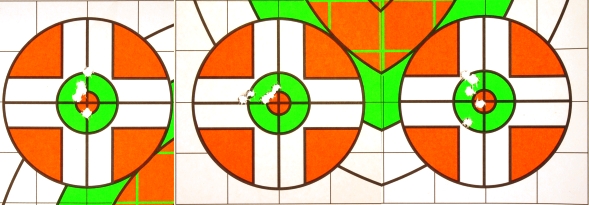
Demonstrated accuracy… precision for those who use the NRA dictionary, for this pistol was excellent. I did not have Model 41 compatible inserts for the Ransom Rest, so these were shot off of sandbags. I would suggest the slight strays are mine, not the pistols, so if I tossed the top and bottom shots on the far left, the Model 41 three shot Remington Golden Bullet ammo within 3/8″ and ditto for the Remington Match. My conclusion is that the gun can easily outshoot me, but it had the ability to make me shoot as good or as better as I ever have.
Wrap up…
 The S&W Model 41 is not inexpensive, which is not the same as saying it is not a lot of pistol for the money. I like wood and blued steel and nicely finished firearms and I shoot them right along side my utilitarian firearms that offer durability over aesthetics. The Model 41’s all steel approach is welcome. Too many firearms these days have poor balance and not enough weight to stabilize them in use.
The S&W Model 41 is not inexpensive, which is not the same as saying it is not a lot of pistol for the money. I like wood and blued steel and nicely finished firearms and I shoot them right along side my utilitarian firearms that offer durability over aesthetics. The Model 41’s all steel approach is welcome. Too many firearms these days have poor balance and not enough weight to stabilize them in use.
The pistol cycled and shot without mishap, regardless type of ammunition, including when shooting from magazines filled with mixed ammunition types. The high grade bluing wiped clean and remained free of scuffs and scrapes in handling. The sights stayed put where set and adjustment was consistent the extent it was easy to walk point of impact to a bullseye while predicting each increment of change.
The Smith & Wesson Performance Center version of the Model 41 made its debut in 2009 as a Davidson’s distributor special, then went on to become standard catalogue. I am not sure if I would spend the extra $250 for the Performance Center version over the standard Model 41 5.5″ pistol, SKU: 130511, or possibly pick up the 7″ barrel standard version, SKU: 130512, at the same $250 lower price.
The Performance Center Model 41 does bring a fancy set of grips, the integrated Picatinny rail and the skeletonized Interchangeable front sight. As I often experiment with various optoelectrical sight systems the rail could be very handy, particularly with the close mount to bore centerline. S&W offers a number of barrels for the Model 41 and there are a good number of aftermarket sight sets, exotic grips and holsters available.
The Smith & Wesson remains as it was in 1957, a legacy grade firearm in performance and appearance. A special firearm to own as a competitor, hunter and recreational shooter who appreciates quality firearms.


Email Notification